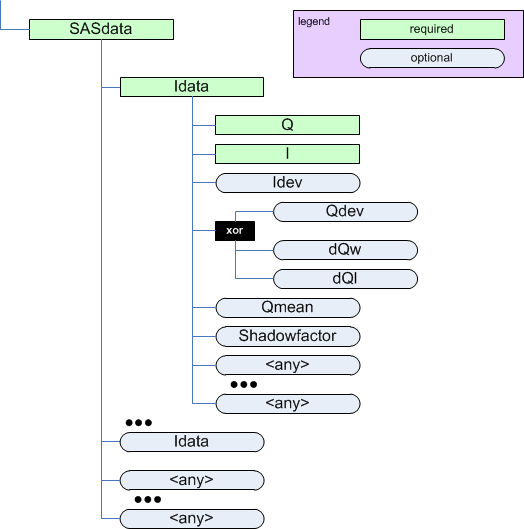SASdata
- parent:
- SASentry
Also, see the drawing of the Q geometry.
| Name |
Type |
Occurrence |
Description |
Attributes |
|---|
| Idata |
container |
[1..inf] |
Each Idata describes a single SAS
data point containing \(I(Q)\) and
other terms. |
|
Idata
- parent:
- SASdata
| Name |
Type |
Occurrence |
Description |
Attributes |
|---|
| Q |
float |
[1..1] |
\(Q=(4 \pi / \lambda) \sin(\theta)\)
as defined in the Rules section.
Either 1/A or 1/nm are typical units. |
unit={unit} |
| I |
float |
[1..1] |
Intensity of the detected radiation.
as defined in the Rules section.
See the section titled
The Intensity Problem for ways to
describe the SAS intensity.
One possibility might be 1/cm for
absolute units when the intensity
describes a differential cross-section
per unit volume per unit solid angle. |
unit={unit} |
| Idev |
float |
[0..1] |
Estimated uncertainty (usually standard
deviation) of I.
It is unexpected for I and Idev
to have different units. |
unit={unit} |
| Qdev |
float |
[0..1] |
Estimated uncertainty (usually standard
deviation) of Q.
It is unexpected for Q and Qdev
to have different units. |
unit={unit} |
| dQw |
float |
[0..1] |
\(Q\) resolution along the axis of
scanning (the high-resolution
slit width direction). Useful for
defining resolution data from
slit-smearing instruments such as
Bonse-Hart geometry.
It is unexpected for Q and dQw
to have different units. |
unit={unit} |
| dQl |
float |
[0..1] |
\(Q\) resolution perpendicular to
the axis of scanning (the low-resolution
slit length direction). Useful for
defining resolution data from
slit-smearing instruments such as
Bonse-Hart geometry.
It is unexpected for Q and dQl
to have different units. |
unit={unit} |
| Qmean |
float |
[0..1] |
Mean value of \(Q\) for this data
point.
Useful when describing data that has
been binned from higher-resolution
or from area detectors.
It is unexpected for Q and Qmean
to have different units. |
unit={unit} |
| Shadowfactor |
float |
[0..1] |
A numerical factor applied to pixels
affected by the beam stop penumbra.
|
|
| {any} |
container |
[0..inf] |
Any element(s) not defined in the
cansas1d:1.1 standard can be placed at
this point. |
xmlns:{foreign-prefix}={foreign-namespace} |
Table Notes
